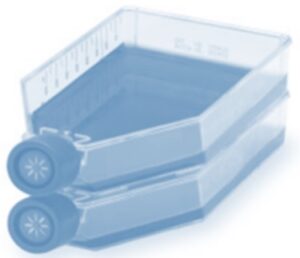NIH3T3 Cell Culture Information
NIH 3T3 Cells
Cells become confluent at a density of approximately 40,000 cells/cm2, and a saturation density of about 50,000 cells can be reached. However, in culture, cells should not be allowed to become completely confluent as this results in cells becoming senescent. NIH3T3 cells have a doubling rate of 20-26 hours and should be cultured in a plastic flask (i.e. they do not adhere well to certain types of glass). The common medium used for culturing NIH3T3 cells is Dulbecco’s Modified Eagle Medium (DMEM) formulated with the addition of 10% FBS. Flasks should be incubated at 37°C in 5% CO2.
NIH3T3 Subculture Protocol

Confluency is a term used to describe a relative measure of how many cells are attached to a flask bottom. As an example, 50% confluency means that in a given field of view under the microscope roughly half of the space will contain growing cells. Cells that are termed “confluent” will be very crowded with little or no space between cells. When cells reach confluency, the cells become stressed and stop growing. To circumvent this, split cells when they are 80-90% confluent.
- Remove medium and rinse cells with Trypsin-EDTA (0.25% Trypsin, and 0.53 mM EDTA)
- Aspirate the trypsin rinse
- Add enough Trypsin-EDTA (i.e. 1-2 mL) and allow the cells to detach (round up); detachment can be encouraged by incubating the flask at 37°C
- After detachment, add 8 mL of complete medium to neutralize the trypsin
- Collect the cell suspension and centrifuge to pellet the cells; aspirate the supernatant
- Split the cells at a ratio of 1:10 or 1:20 into a new culture flask
Subculture every 3 days and renew the complete medium 2 times a week.
NIH3T3 Cryopreservation
Freeze cells in 1 mL of commercially available cell freezing media at a concentration of 1 x 106 cells/mL and store in the liquid nitrogen vapor phase.
Tips
- Confluency
- Too few cells in the flask result in lack of cell growth due to lack of cell contact; too many cells in the flask causes the cells to stop proliferating due to a lack of available growth room in the flask. Cells should maintained between 30-90% at exponential growth.
- Passage Number
- Always record passage numbers on the flask and do not allow high passage numbers. Cells undergo genotypic variations due to high passage number in culture and will become slow growing, hard to transfect and repeated data sets cannot be conclusive as a result of the changing genetics of the cell.
- Cells not detaching from flask
- One of the following may be to blame if cells do not detach from flask during trypsinization step: 1) cells are too confluent and are creating tight junctions; maintain cultures at less than 90% confluency, 2) dissociation agent is weak; try higher concentration along with incubating the flask at 37°C to increase enzymatic activity, and 3) ensure complete washing of flask or perform consecutive PBS washes prior to addition of trypsin.
Links
Stable Cell Line Generation Services
List of Companies Offering Lab Services
Purchase 3T3-Swiss albino cells (ATCC)
NIH3T3 Cells │ NIH3T3 Cell Culture │ NIH3T3 Transfection │ Get NIH 3T3 Transfection Reagent